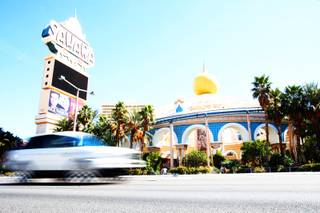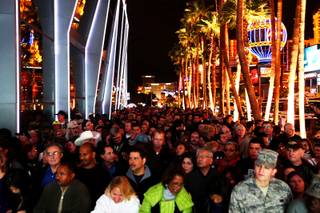VEGAS INC
In its prime, the north end of the Strip — the home to casinos such as the Thunderbird, Silver Slipper and Stardust — defined Vegas glitz. This stretch of the Strip was the stamping grounds for the likes of the Rat Pack, Elizabeth Taylor and Liberace.
Today’s snapshot is a much different picture.
Empty plots of land mark half-completed dreams, where old hotels were razed to make room for billion-dollar luxury resorts that never materialized. Other parcels are harsh, cold reminders of the effects of the recession: billion-dollar resorts that were started but never finished, standing today as headstones for a once-robust economy that all but died.
And now the 58-year-old Sahara is shutting its doors, leaving tourists little reason to venture past Steve Wynn’s shimmering twin towers. An area marked for its early growth has become only a glimmer of what it once was and a symbol of what Las Vegas could have been.
But the recession isn’t all to blame. CB Richard Ellis Executive Vice President John Knott said the shift began in the 1990s when the corporate owner of Circus Circus began sending guests to the south end of the Strip to its Excalibur hotel when the family-oriented resort was full, rather than the other north-end hotels it had partnered with in the past.
“All of a sudden they didn’t need these other hotels and it was like the north end went dark in one night,” Knott said. “It crippled that end of the Strip because they had to rebuild their business base. The development was all happening on the south end, so that was an added challenge.”
A few years later, the construction boom was in full swing on the south end of Las Vegas Boulevard. From the early 1990s until December with the opening of Cosmopolitan, the Strip played host to an opening gala for a new casino every few years, recharging the Strip’s energy and seducing more tourists to town.
During that period, companies began scooping up land in the north end at the height of the market, taking sticks of dynamite to aging properties with plans for bigger and better resorts. It seemed to signal possible rebirth of the north end of the Strip, but was halted in almost an instant.
There was plenty of optimism when Boyd Gaming imploded the Stardust in March 2007 to build its most expensive project yet, the $4.8 billion Echelon hotel and condo development. It was to be the company’s answer to CityCenter — but construction stalled a year later. The company announced in October 2009 construction would not resume for three to five years, leaving steel beams and building materials scattered throughout the site.
Soon after, Treasure Island owner Phil Ruffin sold his 36-acre New Frontier land for $1.2 billion, the largest price-per-acre land sale in the Strip’s history, to the El-Ad Group, which had plans to build an $8 billion luxury hotel similar its Plaza Hotel in New York. The hotel was scheduled to open in 2011, but developers have yet to break ground. The most recent movement on the land was in December 2008 when Wynn had the New Frontier marquee removed before the opening of Encore, saying it was an eyesore.
New Frontier Implosion

Viewing video requires the latest version of Adobe's Flash Player
The New Frontier was imploded Tuesday, Nov. 13, 2007. The 65-year-old casino, the second property built on the famous Las Vegas Strip, was the venue where Elvis Presley made his Las Vegas debut in 1956. It also housed entertainers like Siegfried and Roy, and Wayne Newton; was once owned by eccentric billionaire Howard Hughes, and featured one of the longest union strikes in U.S. history.
Farther north, the $2.9 billion Fontainebleau, stands famously unfinished, the largest commercial construction project to go bankrupt in the country. Carl Icahn, who purchased it out of bankruptcy, has since auctioned off its furnishings and told the Nevada Gaming Control Board in February he has no immediate plans for the structure. At night it’s easy to spot — as a black hole along the Strip’s lights.
And in the midst of building its $8.5 billion CityCenter, MGM Resorts International purchased a 26-acre plot in May 2007 across from the Sahara, which Los Angeles restaurant and nightclub impresario Sam Nazarian had just purchased.
Soon after Nazarian’s purchase of the Sahara, rumors surfaced that he plans to tear down the historic hotel to expand his indulgent Los Angeles SLS Hotel brand. But the official announcement of the Sahara’s demise didn’t come until four years later — and with no discussion of what next would come at the site.
“There a couple of things that need to happen before these projects start up again,” Knott said. “There has to be a change in the business environment because it doesn’t make sense to build when you can’t get a return on your investment. Capital is once again available, so that’s a plus, but you need to have the right environment. Profitability needs to rise to a level they are comfortable with.”
Knott said he doesn’t expect to see any movement on those projects until at least 2014 with openings closer to 2017 or 2018. Echelon and Fontainebleau will likely be the first to restart, but probably not at the scale they were originally planned Knott said.
More luxury resorts and pricey condos might not be what the north end of the Strip needs, anyway. Stephen Brown, director of UNLV’s Center for Business and Economic Research, said the older properties of the northern corridor face competition from Indian gaming in other states.

The New Frontier marquee, which stood on the Las Vegas Strip for over six decades, is disassembled by Young Electric Sign Co. (YESCO) employees and Dielco Crane Service, Inc. on Wednesday. Photo by: Richard Brian
“When you look at the demographics of the people who visit the north end and you look at alternatives that they have, it’s similar to the offerings at Indian casinos in Arizona, New Mexico and California. It’s really when you focus on the newer properties that you see something that is a new experience, something that distinguishes itself from what’s available elsewhere,” Brown said.
Brown agreed it will be a few years before the north end sees any construction, and then, it could be a development other than a resort.
“Our occupancy rate isn’t really high enough to justify other resorts just now. I think it is going to be awhile. This is more a chance for the Las Vegas economy to look to diversify,” Brown said.
Where some might see a wasteland of shelved projects, others see a land of opportunity. It’s an opportunity for Las Vegas to pause and figure out what it really needs. And when those stalled projects breathe life, it will push other Strip properties to reinvent themselves again, Knott said.
“What will happen when the north end of the Strip starts to redevelop, then the market will improve for everyone involved in it,” Knott said. “That will be the new activity level and the new best thing in Las Vegas. The north end of the Strip is an opportunity, but it’s opportunity in the future.”


